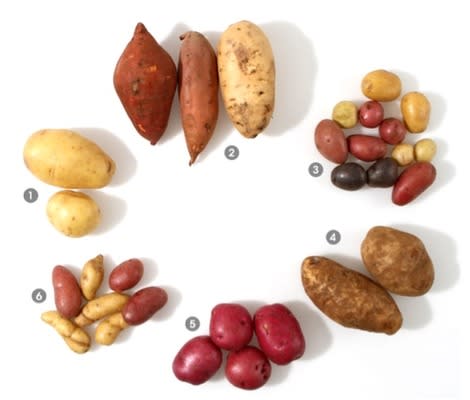Potatoes: Everything You Ever Wanted to Know
Esther Sung

Potatoes are the most consumed vegetable in the United States-roughly 113 pounds per person in 2010-and they're quickly gaining popularity as the most popular food staple in the world, right behind rice. Clearly people don't love the spud because of its looks: Eye candy it's not, with its lumpy shape and bland coloring. Potatoes are also not superconvenient to eat, since they have to be cooked. But in their favor, potatoes are easy to grow and produce a large yield. They're nutritious-high in potassium, vitamin B6, and vitamin C, while sweet potatoes score high on vitamin A and beta-carotene. And then there's the taste. Cooked, the vegetable is transformed from something inedible into one of life's most delicious foods in the form of potato chips, gratins, gnocchi, hash, latkes, samosas, and pierogies. They're used in casseroles, soups, and salads, and can be baked, boiled, fried, and steamed, just to name a few ways to prep them. And unlike so many other types of produce, potatoes are reliably good year-round (although the availability of specific varieties may be seasonally dependent).
It's hard to imagine a potato-less diet. Thanks to early explorers, who first found them in Peru's Andes Mountains, the mighty tuber now grows throughout the world and is embraced by countless culinary traditions. Ideally you'll buy only what you need for immediate use, but if you do need to store potatoes, keep them in a dark, cool, and dry place such as a garage or in a well-ventilated bag or box. If your potatoes start to sprout green eyes or the skins turn green, you can either cut off the green parts or if you think spud is too far gone, just discard altogether. When you cut up potatoes, the pieces may begin to brown; to prevent this discoloration, place them in cold water until you're ready to prep and cook them.
See more: Make Your Own Potato Chips
1. YUKON GOLD
Alternate Names: Yellow
Characteristics: Smooth-skinned and a bit waxy, this now ubiquitous yellow potato was made available to the general public only in 1980. It has a light buttery color on the inside, and when cooked, the Yukon Gold becomes flaky and a bit starchy (although not as much as a russet). Use these when you're looking to mash or shred, but they're waxy enough that they'll also hold their shape if cooked in a soup or stew.
2. SWEET POTATOES
Characteristics: As the name suggests, sweet potatoes are considerably sweeter than other potatoes. They're also larger, heavier, and starchier, and like a russet, the skins are coarse and should be removed before eating. Chances are they're being sold as "yams" in the marketplace, but that's a misnomer. Sweet potatoes look and taste nothing like true yams, which are hard to find. Pictured above are three varieties of sweet potatoes that are marketed as "yams": Garnet, Jewel, and Hannah. Other varieties you may find are Japanese, Beauregard, and Covington. The flesh coloring will vary depending on the type: white, bright orange, deep red-orange, and even purple. And while roasting is a great way to bring out the sweetness, steaming will render them ever so moist and tender while retaining their signature flavor.
See More: The One and Only Truly Belgian Fries
3. BABY POTATOES
Alternate Names: New potatoes, creamers
Characteristics: Immature potatoes-no matter if they're red, yellow, or purple-are deemed baby, new, or creamer. Because of their small size, these potatoes are best cooked whole-boiled, steamed, and even roasted-allowing the skins to add a colorful element to dishes.
4. BROWN RUSSETS
Alternate Name: Idaho
Characteristics: Russets are very starchy potatoes that are long and wide with skins that are dark and earthy, and rough to the touch. If you cut one raw, there's a firmness, and yet when it's cooked, a russet will yield a light, fluffy interior. While the Idaho is not great at retaining its shape, it's the preferred potato for frying, baking, and mashing.
5. RED POTATO
Alternate Names: Red Bliss
Characteristics: Red potatoes have a smooth thin skin that makes for a striking visual contrast against the white flesh. Its skin is edible, so it's not necessary to peel or remove it after cooking. Like many waxy varieties, red potatoes are low in starch and won't produce a light, fluffy texture. However, they are prime candidates for boiling and roasting, and work well in dishes that would benefit from a potato that holds its shape-even when sliced and diced-such as salads and gratins.
See more: Fingerling Potato Salad with Green Chile-Cilantro Salsa
6. FINGERLINGS
Characteristics: Just as their name suggests, fingerlings somewhat resemble fingers. Knobby, slim, firm, and short, these heirloom varieties are mainly found at farmers' markets or specialty gourmet shops. Fingerlings have distinctive flavors, usually nutty or earthy. Pictured left are Russian Banana and French, two of the more abundant types generally available. Both happen to have a waxy yellow flesh, but the French, underneath its red exterior, can sometimes show a streak of red. Other varieties to look for include LaRatte and Purple Peruvian. Roasting keeps these diminutive, uniquely shaped potatoes intact, but they're versatile and can be cooked any which way.
See more from Epicurious:
Delicious Lunch Box Recipes for Kids
Taste Test: 3 Addictive Peanut Butters
Your New Favorite Chicken Recipe

